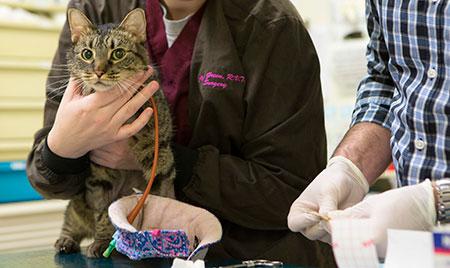
Ellie: First SUB Port Patient
Thursday, January 12, 2017
Ellie Undergoes the First Ureteral Bypass Surgery Performed at OSU
Ellie is a 5 year old cat owned by Alexa Hunter. Hunter, originally from Folsom, Calif., is a member of the class of 2020 at OSU’s Center for Veterinary Health Sciences. So when Ellie stopped eating, Hunter knew exactly where to take her.
“She stopped eating Wednesday night and my husband found vomit where she had thrown up her breakfast,” recalled Hunter. “She refused to eat through Friday and then she threw up a hair ball so it was, okay, that was the issue. But she continued to not eat through the weekend and I had to force feed her. So when Monday morning came, I called the Hospital to see if we could get her on something to start her eating again. It turned into something a little bigger than that though.”
“During her evaluation, we found that one of her ureters was blocked by a ureteral stone or a kidney stone,” explained Dr. Johnattan Arango, small animal surgery resident at OSU’s Veterinary Medical Hospital. “The stone was lodged in Ellie’s ureter so that caused her kidney to become swollen. It was causing her pain and likely the reason she was inappetent and vomiting.”
The surgery team placed a SUB-port in Ellie—the first time the procedure had been done at OSU.
“SUB stands for subcutaneous ureteral bypass port,” he said. “It basically creates a bypass between the kidney and the ureter into the bladder. Usually when we have this problem, there are a couple ways of dealing with it. The main way is to do an ureterotomy which involves cutting into the ureter, taking the stone out and closing the ureter. The problem is that in many cases, scar tissue creates a blockage anyway. Also, the surgery is very minute; it’s a microscopic surgery so there is a lot of potential for complications. Doing a port is easier to perform the surgery and it hopefully prevents any issues with the healing ureter. It’s a more longstanding way to bypass the ureter.”
This was the first time Hunter has used OSU’s Veterinary Medical Hospital.
“It was an amazing team,” said Hunter. “Everyone was very supportive, very nice. Everyone was very helpful—just an overall wonderful experience.”
Ellie spent three nights at the hospital recovering from her surgery. An infection was diagnosed in the affected kidney at the time of surgery. The kidney was flushed and treatment with antibiotics began post-operatively. Two weeks after her discharge, Ellie was back for a re-check to make sure her port was working properly and the infection was coming down. Her sutures were removed and she was good to go.
“It’s a fairly common condition that we see in cats,” added Arango. “We are happy we were able to do the procedure here. Hopefully Ellie continues to do well and she can live a happy life.”
The procedure was started by Dr. Chick Weisse and perfected along with Dr. Allyson Berent. Weisse and Berent have since created “the SUB™ A Subcutaneous Ureteral Bypass System,” which is a surgical guide for veterinarians.
